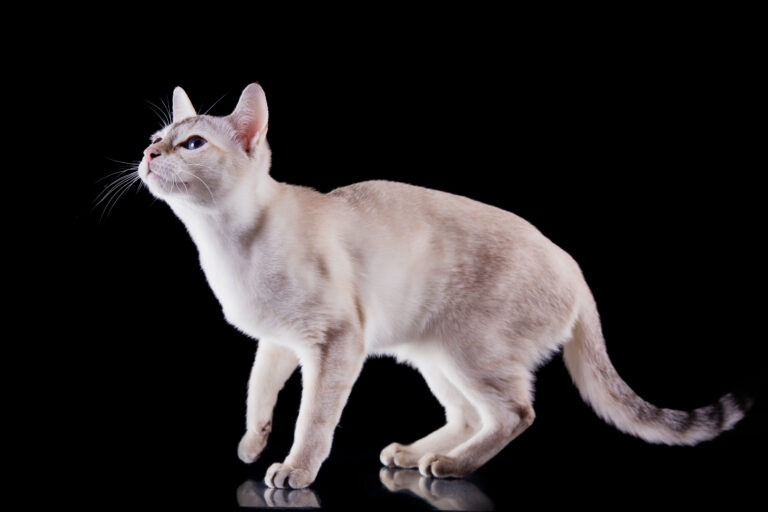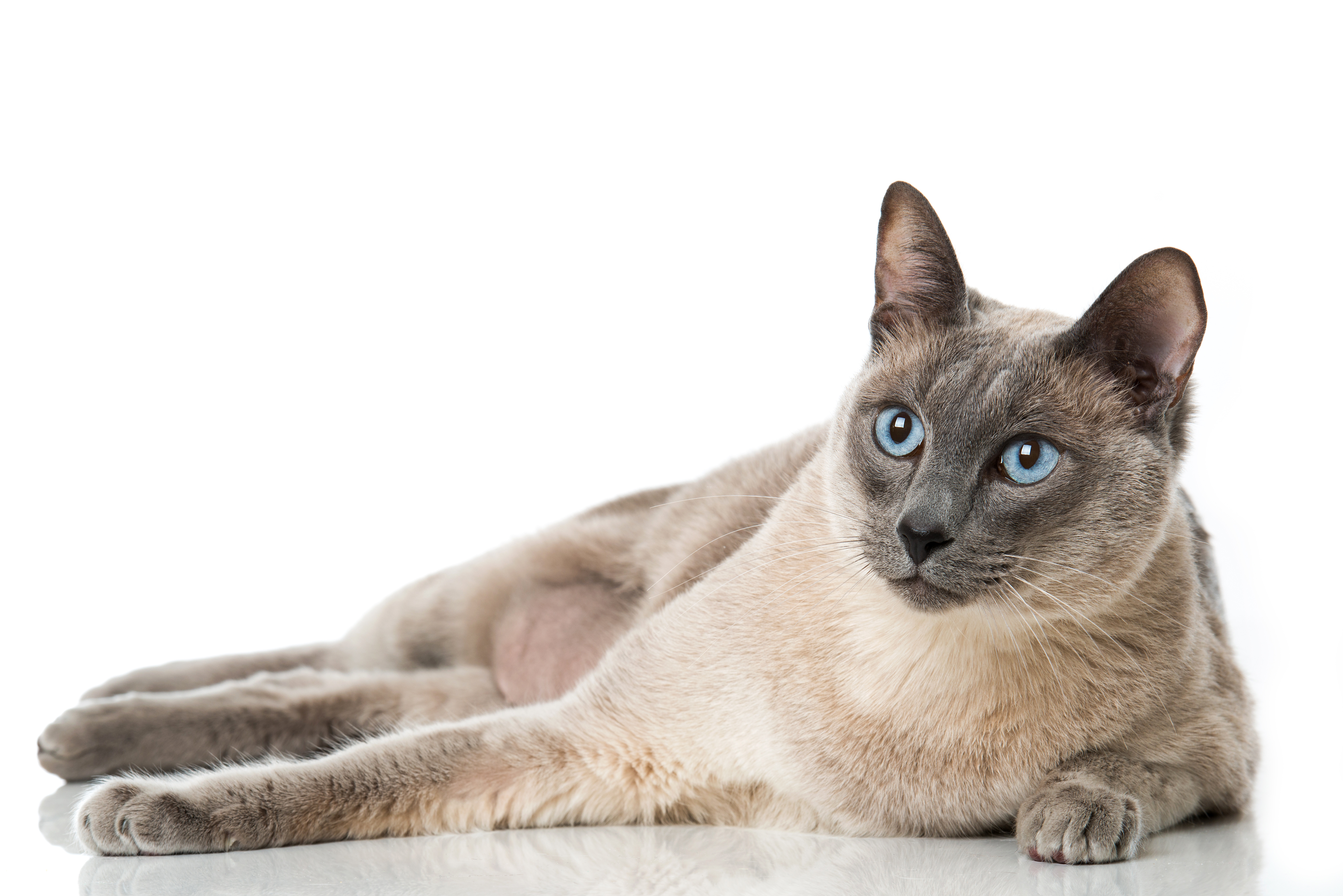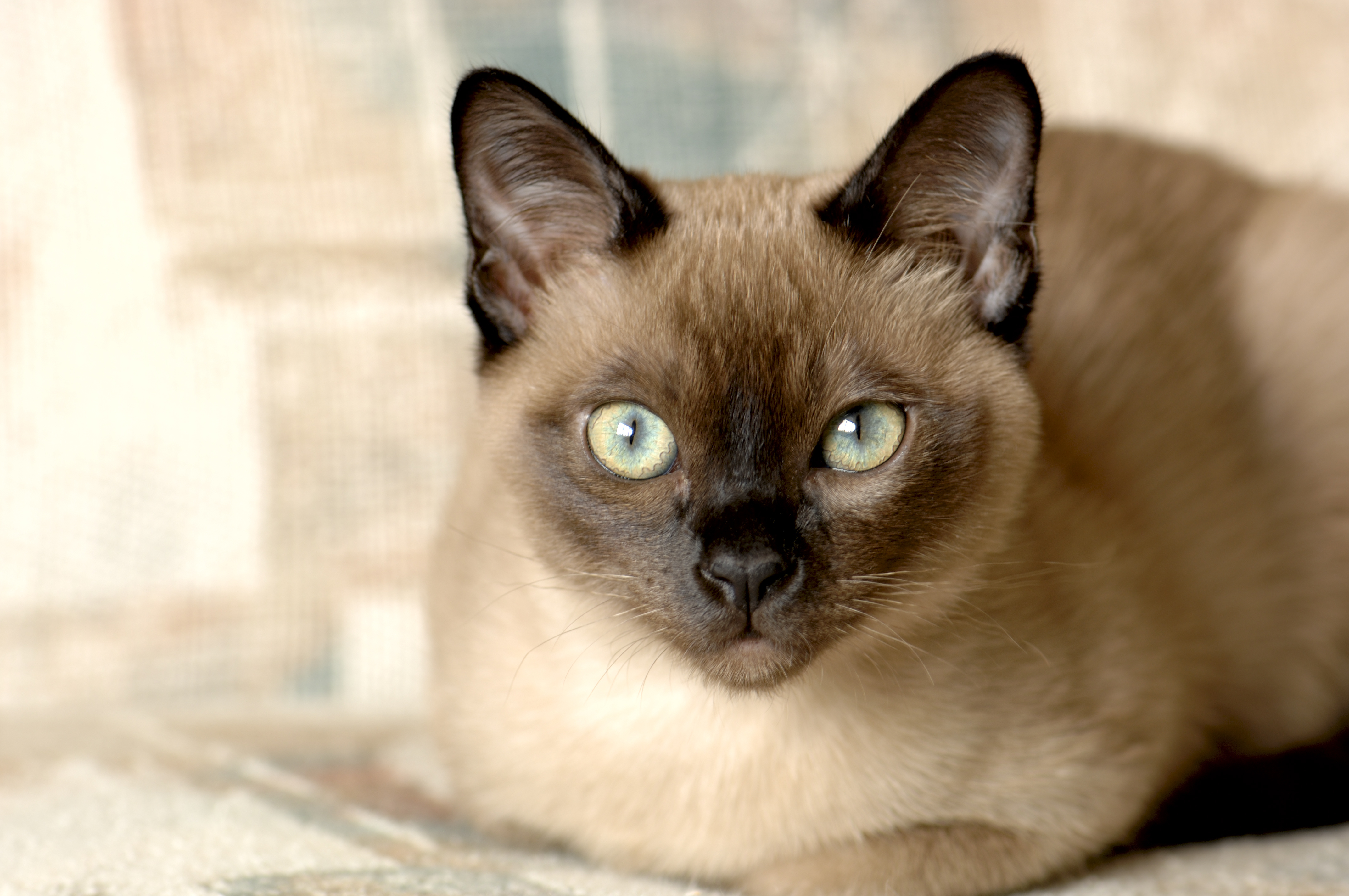Maine Coon
The Maine Coon has now become one of the most popular cat breeds in the world and is enjoying increasing popularity in Ireland, too. This is probably thanks to its authenticity, robustness and excellent character.
Despite its famous progenitors, the Burmese and Siamese, the Tonkinese is a relatively rare cat breed. With their slim, muscular body and short fur, these attractive cats combine many positive characteristics of their ancestors. Affectionate, sociable and curious, they are excellent for families that wish to spend a lot of time with their pet.

© annaav / stock.adobe.com
Feline experts will discover many characteristics in the attractive Tonkinese that they recognise from the Burmese and Siamese. It’s no surprise that the Tonkinese came about from pairing these two Thai cat breeds. Like the Burmese, it its very lively and communicative, though it doesn’t usually miaow as loud as the Burmese. At the same time, it is extremely affectionate and people-focused. In this respect, it very much resembles the Siamese, which is playfully described as a “dog among cats”.
You can immediately spot the Tonkinese’s curious nature. It observes its environment alertly with large, expressive almond-shaped eyes. It has a slim, muscular and graceful body with shiny, silky fur. Its size and weight are well balanced and the legs, body and head form a harmonious unit.
The Tonkinese is medium-sized and weighs between 3 and 5kg, with females generally slightly lighter than males. Their medium-length legs are slim and give them an active and sporty appearance. The rear legs are slightly longer than the front legs. The short fur lies close to the body and has a soft glow. It is found in the base colours natural, blue, chocolate and lilac, though the standard permits red, cream, tabby and tortie varieties. These are split into the following three colour types:
Like its ancestors, the Tonkinese feels happiest with company. Of course it particularly values interaction with fellow cats, but it loves spending time together with its human family. Playing and cuddling with them and receiving their full attention is the best thing of all for the sociable and people-focused Tonkinese. Its behaviour sometimes brings to mind a dog that wishes to please its family and is happiest following them at every turn. The curious and playful Tonkinese doesn’t even consider itself above practising little tricks. The main thing is it being fully involved and getting enough attention.
The sociable Tonkinese feels happy with people who have time for it and know how to stimulate it both mentally and physically. It isn’t a cat you can keep on a casual basis or leave alone for the entire day, because its need for attention is too great. Nevertheless, it can adapt well to its family and their day-to-day life and doesn’t get overwhelmed by the chaos of family life. Instead of running away from children who play loudly, as many of its fellow cats do, the Tonkinese prefers being involved with games and frolics. With its friendly, loving and playful manner, it is perfectly suited for a family with children – provided that all family members give it enough attention and the feeling of fully belonging everywhere it goes.
 © DoraZett / stock.adobe.com
© DoraZett / stock.adobe.com
The history of the Tonkinese is similar to that of the Burmese, since both breeds can be traced back to the cat Wong Mau. The American ship’s doctor Jospeh C. Thompson discovered this cat with unusually coloured fur (a warm brown that merges into darker points on the ears, facial mask, tail and legs) in Rangoon (Burma, now Myanmar) and brought it to his home city of San Francisco in 1930. He thought it was a Siamese at first and paired it with a male Siamese. However, in contrast to what was expected, the result of this pairing wasn’t a pure Siamese litter, but a diverse mix of kittens that resembled present-day Burmese, Siamese and Tonkinese cats.
As it emerged, Wong Mau wasn’t a Siamese but the representative of a special variety of temple cats. In the US, targeted breeding continued with the offspring that embodied the present-day Burmese type. Tonkinese-type cats were neglected. In Canada, however, the variety was the subject of increasing interest. Hence, Canadian breeders were the first to focus on targeted breeding of the Tonkinese type, which was called the Golden Siam. In 1965, the breed was finally recognised by the Canadian breeding association, though it is still not acknowledged as an independent breed by all feline associations in the US and Europe. Although associations like the World Cat Federation (WCF) and The International Cat Association (TICA) list it as an independent breed, the FIFé (Fédération Internationale Féline) still hasn’t expressed this judgement.
Breeding the Tonkinese isn’t easy, because cats similar to the Siamese and Burmese always end up in the litters. This isn’t the case when crossing Burmese and Siamese cats: this results in Tonkinese cats without exception. However, pairing Burmese and Siamese cats does require exactly knowledge of the lineage and requires great caution. In addition, this is only permitted in the first generations. From the second generation, breeders can only pair Tonkinese cats with one another.
You may have to factor in long distances, because there are very few breeders in Europe. Nevertheless, you should definitely steer clear of dubious online businesses offering cute kittens at a bargain price. These are mostly run by irresponsible breeders who pair cats without specific knowledge of the lineage or health check-ups. The result is often sick cats with little in common with a genuine Tonkinese, which is robust, healthy and sociable.
To stay on the safe side, contact a responsible Tonkinese breeder with several years of experience working with the breed. Responsible breeders make sure that cats get a healthy start in life, can spend the first few weeks of their life growing up within their feline pack and the breeder’s own family and that they are sufficiently socialised. They give kittens away at the age of 10 to 12 weeks at the earliest and ensure that they have been dewormed on several occasions and have received the necessary vaccinations. As well, cats from a scrupulous breed will come with a family tree and a clean bill of health from the vet.
If you don’t wish to wait so long to obtain a young Tonkinese from a breeder, you can alternatively look in a nearby animal shelter to see how many cats are waiting for a new home. With a bit of luck, there may even be a rare Tonkinese.
Genuine Tonkinese cats are very robust with no diseases known to be typical of the breed. They have a high life expectancy of 15 to 18 years. Of course, responsibility for a healthy feline life isn’t just down to the breeder. As a cat owner, the health of your pet is in your hands. Ongoing routine check-ups with the vet and regular grooming and frequently checking the ears and teeth are compulsory and ensure that an inflammation or similar ailment can be detected at an early stage and has a good chance of being cured. Don’t worry though, because the Tonkinese’s short fur is very low-maintenance. Comb it several times a week with a soft brush or rub it with a damp cloth – this keeps it shiny for a long time.
Diet also has a crucial influence on a cat’s fitness, health and life expectancy. There is often a lot of uncertainty: what brand is the right one for my cat? Am I better off choosing wet or dry food? And what’s the score with BARF? First of all, don’t let other cat owners and so-called dietary experts drive you crazy. The decision as to what food is best for your cat is for you and your cat alone. After all, every cat is very individual – therefore its needs and options are very different too. One cat with outdoor access is very active, another sleeps a lot, one has a chronic illness, another has a tendency to gain weight, one is old, another is young – the list is never-ending.
Discover our selection of dry and wet cat food!
 © Carolina K Smith MD / stock.adobe.com
© Carolina K Smith MD / stock.adobe.com
In principle, the best cat food isn’t necessarily the most expensive. More important than the price, brand or type (dry, wet or raw) is whether food meets your cat’s needs. Before you choose, you should ask yourself what your Tonkinese really needs. Is it a very active outdoor cat? Then it probably needs a food containing more energy than cats kept solely indoors do. It is still growing or is it old of age? In this case too, nutritional requirements are very different. Dietary and nutritional tables can be helpful to determine exact quantities. In-depth discussion with the breeder or a vet is advised to understand your cat’s individual nutritional requirements.
This sounds more complicated than it really is. Thankfully, there are now several providers producing very high-quality foods for special ages, breeds or intolerances (e.g. grain-free, hypoallergenic) to give the Tonkinese a straightforward but healthy diet. The proportion of meat for a healthy adult cat should be around 60 to 70% as the guideline for a balanced mix of food. The amount of vegetables and fruit containing the required vitamins, fibres and carbohydrates along with animal protein should be around 20 to 30%. However, cats hardly have any need for grain in the form of wheat, oats, rye, barley, maize or millet, since the carbohydrates they contain are difficult for them to digest and utilise.
The Tonkinese is eye-catching with its uniquely coloured fur and large, expressive eyes. Their many positive characteristics, sociable and people-focused nature, self-confidence and adaptability make them interesting for future cat owners. Before searching for a breeder, consider whether you can dedicate time to keeping your cat in a species-appropriate manner.
Tonkinese cats like their family to pay them attention and show affection – be it in the form of play or cuddles. At the same time, they very much value outdoor access. Hence, living in the countryside with space for roaming freely and no dangerous multi-lane roads close by suits these cats. People who live in cities can keep them solely as indoor cats, but should make sure that they get enough exercise and diverse activity within the four walls of their home. They should have access to cat toys, a climbing and scratching tree and ideally a playmate in the form of a second cat. You should generally ensure that your Tonkinese isn’t alone too often. The Tonkinese is extremely sociable and feels happiest in the company of fellow cats and people.
If you live in quiet area, have several hours a day to dedicate to your pet and are open to purchasing a second cat, the Tonkinese is certainly a perfect companion for you and will bring plenty of joy to your day-to-day life with its charming ways.
The Maine Coon has now become one of the most popular cat breeds in the world and is enjoying increasing popularity in Ireland, too. This is probably thanks to its authenticity, robustness and excellent character.
Neva Masquerade – a mysterious name for a mysterious thing of beauty! The Neva Masquerade is the point variation on the Siberian cat and shares many characteristics with this breed.